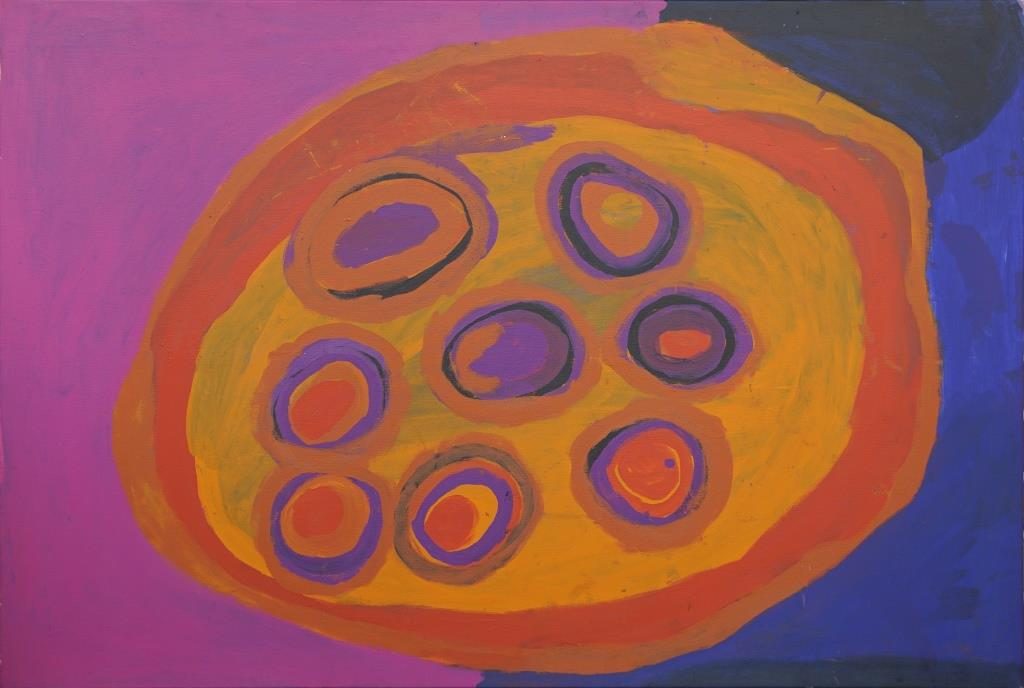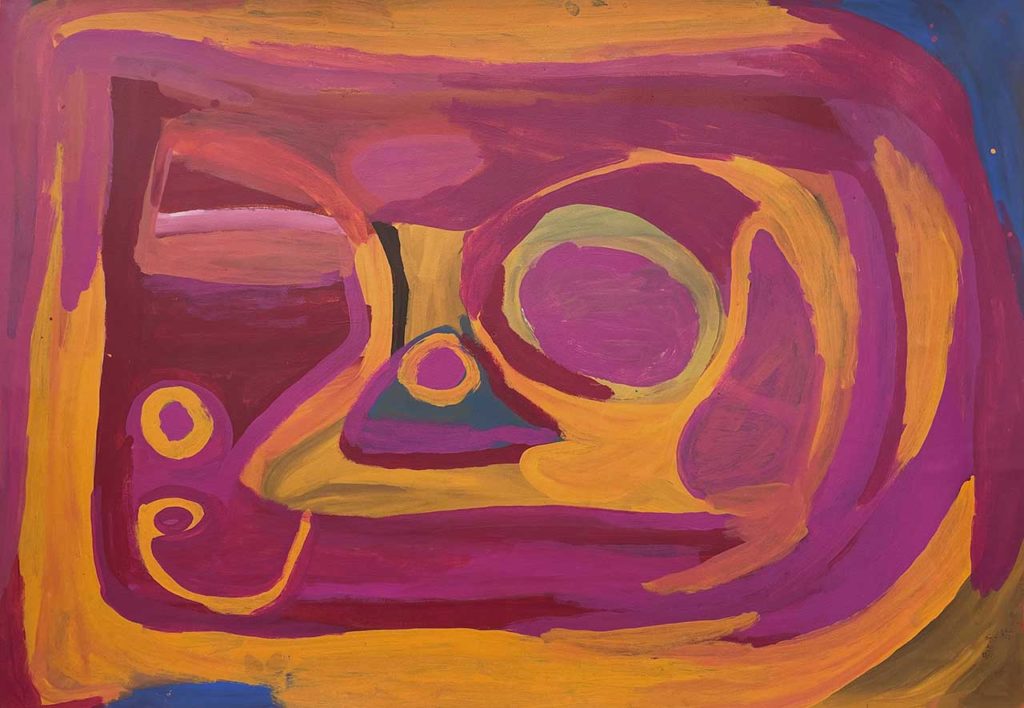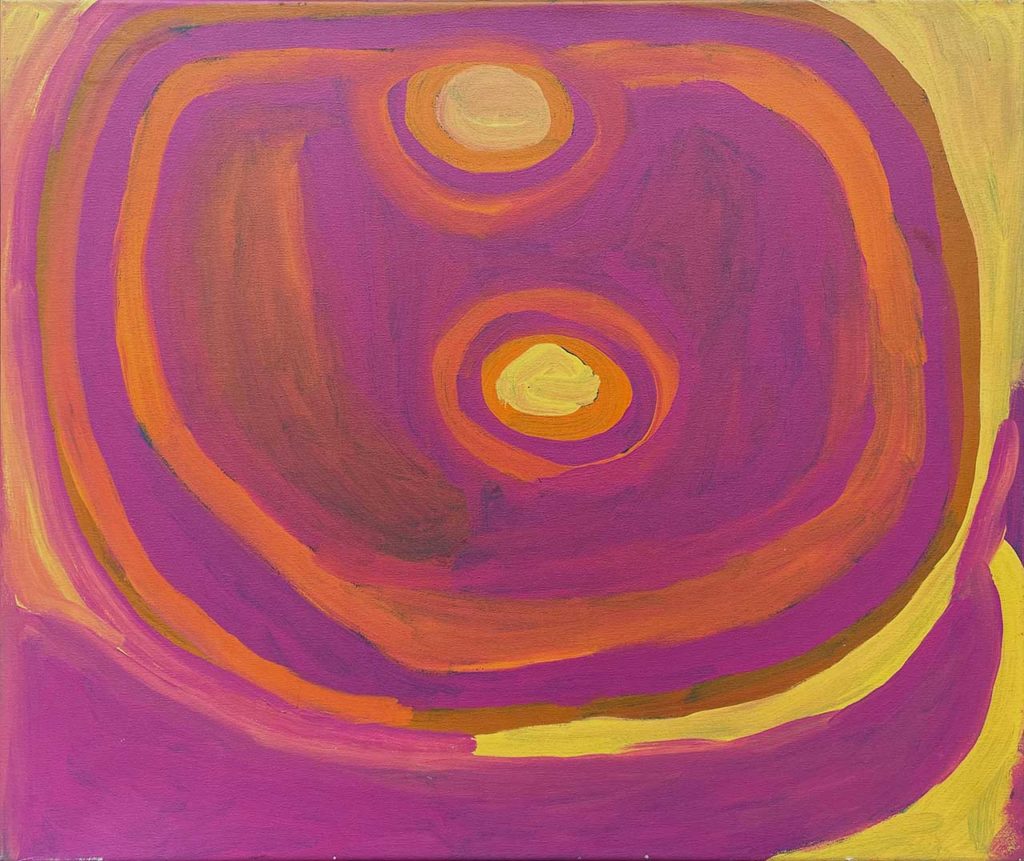Stumpy Brown – Ngupawarlu My Country – Walk Through
David Wroth shares some of the highlights from the Stumpy Brown 2022 exhibition at Japingka Gallery. He answers some questions about what he observed while working with the late Stumpy Brown.
In Gallery 2 we have an exhibition from Nyuju Stumpy Brown. Stumpy was one of the great painters from Fitzroy Crossing area. She was born out on the Canning Stock Route and was the senior law custodian for the water site at Ngapawarlu, which was the constant subject of all her paintings.

Stumpy Brown painted through the 1990s and 2000s and she's now passed away. This wonderful collection of paintings shows the power of her ancestral site at Ngupawarlu in the Great Sandy Desert. She developed her painting skills in Fitzroy Crossing, which was known for its strong use of colour, and constantly over-washing layers of colour to build up a view of country. Always at the centre of the paintings is the water hole and the law grounds of country. Ngapawarlu is the centre of all the titles, so sometimes it's "Ngapawarlu My Country", or "Women's Law Story From Ngapawarlu". In all of her work, the artist was constantly referring to this one great location on her traditional country.
Stumpy Brown was the sister of one of the Kimberley's most famous painters, Rover Thomas. Both brother and sister travelled north up the Canning Stock Route to live in townships that were off country. Stumpy moved along the Canning Stock Route to arrive at Balgo and then travelled back in a south-westerly direction following the roads back towards Fitzroy Crossing. She spent a long time in Wangkatjungka and also lived in the township of Fitzroy Crossing. Rover Thomas moved further north, so his journey took him further into the cattle station country at Turkey Creek, which became Warmun and subsequently a very famous art centre for ochre painters.

Her brother Rover Thomas became a central figure in using the ochre pigments that were part of ceremonial boards that were painted and carried by performers in dance rituals in Warmun. Stumpy, still living in Fitzroy Crossing, came through a different artistic development where colour was used loosely, originally through painting on cotton based paper.
The artists at Fitzroy Crossing developed something like a watercolour technique by over-washing layers of transparent paint. This is how the artists built up the surfaces they wanted. Stumpy's style is in stark contrast to the style of Rover Thomas. They represent polar opposites of Kimberley painting - one very much based on using ochres and the other using colour, which gives a more contemporary feel. However the subject matter remains this very strong connection to particular sites along the Canning Stock Route.

Q&A
Q. Are all these works from later in Stumpy Brown's career?
A. Yes, the paintings that are on exhibition are all from the last five or six years of the artist's life. She was well into her 70s when she painted these works. She was a very authoritative figure in the way she painted and authoritative in the way that she was recognised as a senior law woman and custodian. Her demeanour reflected her position.
Q. How did this collection of Stumpy Brown artworks come about?
A. Japingka were involved in doing art development projects in Wangkatjungka community. We were involved with a school project there and working with many of the senior artists as well. (See link below) We were setting up painting workshops and supplying materials in that community and initially Stumpy wasn't involved.
This was around 2002 and Stumpy wasn't part of the original group. She was living with her family in Fitzroy Crossing at the time. After a number of years, she did want to be involved with that original group of artists. They saw themselves as a distinct group, separate from the artists in Fitzroy Crossing. They didn't have their own art centre but they wanted to maintain their own kind of cooperative as a group.
Stumpy had lived at the community and often visited there and she began painting with the group. That is how Japingka came to meet Stumpy and acquire a number of her paintings from the era 2002 through to 2007. A number of Stumpy Brown artworks were exhibited and sold by galleries around that time.
Read The 3 Part Series: The Wangkatjungka Remote School Mentors Project

Q&A
Q. Why do these paintings have such a strong contemporary feel?
A. I think what makes Stumpy Brown's paintings feel so contemporary and links them so much with Western abstract painting is the boldness with which she approaches the painting. There's not a great emphasis by the artist on the precise delineation of areas of colour and design. In fact Stumpy would lay on the structure of the painting using a large brush, and she would keep laying on sections of colour over the top until she got the result that she was looking for. There's an expressionist quality to it. You can tell the artist was making the artwork with broad brush sweeps. She was going for big impact using large blocks of colour. There was no concern for fine points of detail and where one section of colour meets another. That looseness and that expressionist quality is what connects her in our minds to certain kinds of contemporary abstract painting.
Q. What do you remember about watching her paint?
A. It's quite extraordinary, I think at first I was aware that artists who started painting on good quality cotton paper could work "wet on wet" as they call it. This means there's no waiting for one section of the painting to dry. They just keep layering on extra washes of colour, and so aspects of what's underneath will show through. There's quite a loose finish where one coat goes in over the other. I felt amazed that she was laying down these loose bands of colour. She was using these big brushes and it was actually the sweep of her arm forming a lot of the design structures. She would sit on the canvas or by the canvas and the shape of the design was the sweep of her arm as she swung around with a brush in her hand.
That was the sort of authority and the sort of freedom that Stumpy had in making the paintings. You could see it as she moved across the canvas. She was spreading paint onto the canvas with big brushes, and then she would be constantly shaping it with the next layer of colour to bring up the design.
I'd just watch it build up and there may be six layers of paint, but it's all quite thinly applied, so there'd be this "washy" paint effect on canvas which I think is quite unusual. Maybe that also links it to American abstract expressionist paintings of the 1950s, because some prominent artists used to dilute paint and more or less tip or flood it across the big areas of canvas, and then work on it from there, which is exactly what Stumpy Brown did. I feel certain she would never have seen that kind of American art approach as she lived in such a remote part of the world. It just flowed from her naturally.

Q&A
Q. What did Stumpy Brown say to you about her work? Do you ever remember her talking about it?
A. Many Aboriginal artists create work that closely identifies the artist with a special or sacred location, so there's no separation for them. They never stand back and analyse their artwork. They will say something like, "Oh, that is Ngapawarlu, that is the ceremonial site". If you ask, "why did you do it this way or why is this painting different to the previous painting", you don't get any analytical feedback as to why it happened in that way. Stumpy Brown was very much in that mold. It's like this is what was happening to me when I was painting that subject on that day and that's the finished result.
Q. Did this Stumpy Brown come back and rework paintings?
I think Stumpy kept putting layers on until she was satisfied. Sometimes I would be uncertain whether the painting was finished. She would go away and have a cup of tea and might leave it for a time. When I came back, the painting may have changed or it may not have. So I guess like all artists, while the painting sits there, they will make judgments about whether they want to do something more to it or just say, "okay, that's finished"
The Stumpy Brown exhibition can be viewed in Gallery 2 from 8 April to 18 May 2022.
